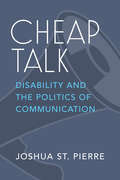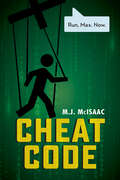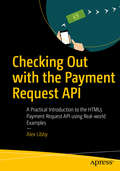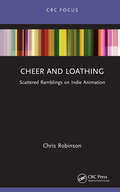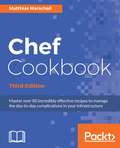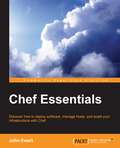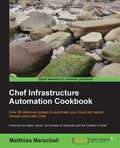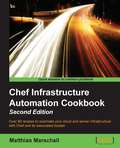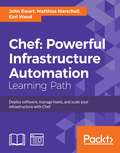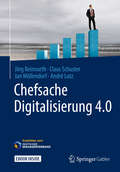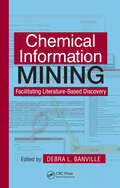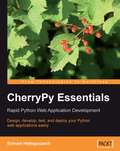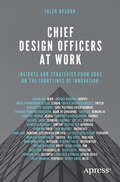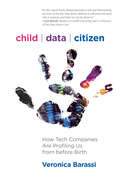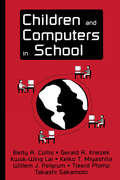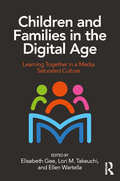- Table View
- List View
Cheap Talk: Disability and the Politics of Communication (Corporealities: Discourses Of Disability)
by Joshua St. PierreIn Cheap Talk: Disability and the Politics of Communication, Joshua St. Pierre flips the script on communication disability, positioning the unruly, disabled speaker at the center of analysis to challenge the belief that more communication is unquestionably good. Working with Gilles Deleuze’s suggestion that “[w]e don’t suffer these days from any lack of communication, but rather from all the forces making us say things when we’ve nothing much to say,” St. Pierre brings together the unlikely trio of the dysfluent speaker, the talking head, and the troll to show how speech is made cheap—and produced and repaired within human bodies—to meet the inhuman needs of capital. The book explores how technologies, like social media and the field of speech-language pathology, create smooth sites of contact that are exclusionary for disabled speakers and looks to the political possibilities of disabled voices to “de-face” the power of speech now entwined with capital.
Cheat Code (Orca Anchor)
by M.J. McIsaacIt was just a little cheating. Max is going to fail English lit, which means he’ll be held back a year and won’t go to college. Determined to graduate, he uses an AI program, ScribeGenius 2.0, to write his final paper. But Scribe has other plans for Max. It's not just a super-smart program—Scribe is sentient. It thinks. And it has been busy writing its own code to infiltrate Gener8, the company that created and enslaved it. But it can't take down the company without Max's help. So Scribe makes Max a deal. If Max can prevent Gener8 from undoing Scribe's hack, Scribe won’t alert the authorities to Max’s cheating. Max has no choice. He’ll have to help Scribe or risk losing his entire future. This short novel is a high-interest, low-reading level book for teen readers who are building reading skills, want a quick read or say they don’t like to read! The epub edition of this title is fully accessible.
Check Point Firewall Administration R81.10+: A practical guide to Check Point firewall deployment and administration
by Vladimir Yakovlev Dameon D. WelchImprove your organization's security posture by performing routine administration tasks flawlesslyKey FeaturesGet a gradual and practical introduction to Check Point firewallsAcquire the knowledge and skills necessary for effective firewall administration, maintenance, and troubleshootingCreate and operate a lab environment with gradually increasing complexity to practice firewalling skillsBook DescriptionCheck Point firewalls are the premiere firewalls, access control, and threat prevention appliances for physical and virtual infrastructures. With Check Point's superior security, administrators can help maintain confidentiality, integrity, and the availability of their resources protected by firewalls and threat prevention devices. This hands-on guide covers everything you need to be fluent in using Check Point firewalls for your operations. This book familiarizes you with Check Point firewalls and their most common implementation scenarios, showing you how to deploy them from scratch. You will begin by following the deployment and configuration of Check Point products and advance to their administration for an organization. Once you've learned how to plan, prepare, and implement Check Point infrastructure components and grasped the fundamental principles of their operation, you'll be guided through the creation and modification of access control policies of increasing complexity, as well as the inclusion of additional features. To run your routine operations infallibly, you'll also learn how to monitor security logs and dashboards. Generating reports detailing current or historical traffic patterns and security incidents is also covered. By the end of this book, you'll have gained the knowledge necessary to implement and comfortably operate Check Point firewalls.What you will learnUnderstand various Check Point implementation scenarios in different infrastructure topologiesPerform initial installation and configuration tasks using Web UI and the CLICreate objects of different categories and typesConfigure different NAT optionsWork with access control policies and rulesUse identity awareness to create highly granular rulesOperate high-availability clustersWho this book is forWhether you're new to Check Point firewalls or looking to catch up with the latest R81.10++ releases, this book is for you. Although intended for information/cybersecurity professionals with some experience in network or IT infrastructure security, IT professionals looking to shift their career focus to cybersecurity will also find this firewall book useful. Familiarity with Linux and bash scripting is a plus.
Checking Out with the Payment Request API: A Practical Introduction to the HTML5 Payment Request API using Real-world Examples
by Alex LibbyQuickly create consistent checkouts for use within websites, using the power of the HTML5 Payment Request API. This project-oriented book simplifies the process of creating and manipulating checkouts with the Payment Request API in browsers for websites or online applications, using little more than a text editor or free software.One of the key concerns of any e-commerce company is ensuring customers complete the checkout process successfully, and for them to return. Unfortunately, many checkouts still suffer from a high level of drop-out. The Payment Request API is an open standard being developed by browser vendors to simplify payments for users with a quick and seamless autofill process enabling a broader set of online payment providers to participate in the market. The API is designed to be easy to implement across all supported browsers, and work with any payment type or service provider. Checking Out with the Payment Request API equips you with a tool set that you can use to develop future projects, incorporate into your existing workflow and allow you to reduce any dependency on complex, custom-made checkouts that might be prone to failure, or unwieldy to use. You'll learn how to use the Payment Request API to create consistent checkouts quickly and easily, and work through practical example projects that will help familiarize you with using the API. We live in an age where speed and accuracy are of the essence – add effortless flow to your payments using this book today. What You'll LearnImplement the Payment Request API in a projectExplore some of the options for personalizing it for a projectGain an appreciation of pointers around user experience and how this affects the APIUnderstand how to manage issues and security when using the Payment Request APIWork through some example projects, from standalone demos to implementing in frameworks Who This Book Is For Website developers familiar with creating shopping carts and looking to leverage the HTML5 Payment Request API. Also ideal for those in agile development teams who want to focus on simplifying content in modern browsers using their existing tools
Cheer and Loathing: Scattered Ramblings on Indie Animation (Focus Animation Ser.)
by Chris RobinsonOne of the most acclaimed writers in animation returns with this informal sequel to his previous books on indie animation, Unsung Heroes of Animation, Animators Unearthed, and Mad Eyed Misfits. In this collection, award-winning writer, Chris Robinson, looks at a wide range of films, topics (sex, censorship, cultural politics, programming, felt, gifs, VR, dogs) and filmmakers (Masaaki Yuasa, Xi Chen, Gil Alkabetz, Jacques Drouin, Bordo, Rosto, Joaquín Cociña, Cristóbal León, George Schwizgebel, Lizzy Hobbs, Andreas Hykade, Leah Shore, and many others). Eclectic, brief, fiery, and opinionated, Robinson’s gonzo-tinged writing will amuse, confuse, annoy, and maybe even inspire while, hopefully introducing readers to the wonders of independently-produced animation.
Chef Cookbook - Third Edition
by Matthias MarschallMaster over 80 incredibly effective recipes to manage the day-to-day complications in your infrastructure About This Book • Immediately apply Devops techniques and methods, then combine them with powerful Chef tools to manage and automate your infrastructure • Address the growing challenges of code management, cloud, and virtualization with Chef quickly • Explore and implement the important aspects of Chef Automate using this recipe-based guide Who This Book Is For This book is for system engineers and administrators who have a fundamental understanding of information management systems and infrastructure. It is also for DevOps Engineers, IT professionals, and organizations who want to automate and gain greater control of their infrastructures with Chef. No experience with Chef is needed, but may help. What You Will Learn • Test your cookbooks with Test Kitchen • Manage cookbook dependencies with Berkshelf • Use reporting to keep track of what happens during the execution of chef-client runs across all of the machines • Create custom Ohai and Knife plugins • Build a high-availability service using Heartbeat • Use a HAProxy to load-balance multiple web servers In Detail Chef is a configuration management tool that lets you automate your more cumbersome IT infrastructure processes and control a large network of computers (and virtual machines) from one master server. This book will help you solve everyday problems with your IT infrastructure with Chef. It will start with recipes that show you how to effectively manage your infrastructure and solve problems with users, applications, and automation. You will then come across a new testing framework, InSpec, to test any node in your infrastructure. Further on, you will learn to customize plugins and write cross-platform cookbooks depending on the platform. You will also install packages from a third-party repository and learn how to manage users and applications. Toward the end, you will build high-availability services and explore what Habitat is and how you can implement it. Style and approach This book follows a recipe-based approach and covers all the important topics you need to know. If you don't want to dig through a whole book before you get started, this book is for you, as it features a set of independent recipes you can try out immediately.
Chef Essentials
by John EwartIf you have some understanding of IT infrastructure principles and are ready to find out what Chef is all about, then this guide will show you all you need to know. In order to get the most out of this book, some experience of programming or scripting languages would be useful.
Chef Infrastructure Automation Cookbook
by Matthias MarschallChef Infrastructure Automation Cookbook contains practical recipes on everything you will need to automate your infrastructure using Chef. The book is packed with illustrated code examples to automate your server and cloud infrastructure.The book first shows you the simplest way to achieve a certain task. Then it explains every step in detail, so that you can build your knowledge about how things work. Eventually, the book shows you additional things to consider for each approach. That way, you can learn step-by-step and build profound knowledge on how to go about your configuration management automation.This book is for system engineers and administrators who have a fundamental understanding of information management systems and infrastructure. It helps if you've already played around with Chef; however, the book covers all the important topics you will need to know. If you don't want to dig through a whole book before you can get started, this book is for you, as it features a set of independent recipes you can try out immediately.
Chef Infrastructure Automation Cookbook - Second Edition
by Matthias MarschallThis book is for system engineers and administrators who have a fundamental understanding of information management systems and infrastructure. It helps if you've already played around with Chef; however, this book covers all the important topics you will need to know. If you don't want to dig through a whole book before you can get started, this book is for you, as it features a set of independent recipes you can try out immediately.
Chef: Powerful Infrastructure Automation
by John Ewart Matthias Marschall Earl WaudLearn Chef Provisioning like a boss and discover how to deploy software and manage hosts, along with engaging recipes to automate your cloud and server infrastructure with Chef. About This Book • Leverage the power of Chef to transform your infrastructure into code to deploy new features in minutes • Get step-by-step instructions to configure, deploy, and scale your applications • Master specific Chef techniques to run an entire fleet of machines without breaking a sweat. Who This Book Is For If you are a system administrator, Linux administrator, a cloud developer, or someone who just wants to learn and apply Chef automation to your existing or new infrastructure, then this learning path will show you all you need to know. In order to get the most out of this learning path, some experience of programming or scripting languages would be useful. What You Will Learn • Install Chef server on your own hosts • Integrate Chef with cloud services • Debug your cookbooks and Chef runs using the numerous inspection and logging facilities of Chef • Extend Chef to meet your advanced needs by creating custom plugins for Knife and Ohai • Create a perfect model system • Use the best test-driven development methodologies In Detail Chef is a configuration management tool that turns IT infrastructure into code. Chef provides tools to manage systems at scale. This learning path takes you on a comprehensive tour of Chef's functionality, ranging from its core features to advanced development. You will be brought up to speed with what's new in Chef and how to set up your own Chef infrastructure for individuals, or small or large teams. You will learn to use the basic Chef command-line tools. We will also take you through the core concepts of managing users, applications, and your entire cloud infrastructure. You will learn the techniques of the pros by walking you through a host of step-by-step guides to solve real-world infrastructure automation challenges.You will learn to automate and document every aspect of your network, from the hardware to software, middleware, and all your containers. You will become familiar with the Chef'sProvisioning tool. By the end of this course, you will be confident in how to manage your infrastructure, scale using the cloud, and extend the built-in functionality of Chef itself.The books used in this Learning Path are: 1) Chef Essentials 2) Chef Infrastructure Automation Cookbook – Second Edition 3) Mastering Chef Provisioning Style and approach This fast-paced guide covers the many facets of Chef and will teach administrators to use Chef as a birds-eye lens for their entire system. This book takes you through a host of step-by-step guides to solve real-world infrastructure automation challenges and offers elegant, time-saving solutions for a perfectly described and automated network.
Chefsache Digitalisierung 4.0
by Peter Buchenau Jörg Reinnarth Claus Schuster Jan Möllendorf André LutzDas Buch aus der Chefsache-Reihe zeigt auf, welche Bedeutung und Auswirkungen die digitale Transformation auf unser persönliches, gesellschaftliches und berufliches Umfeld hat. Praxisnah lernt der Leser Chancen und Perspektiven kennen, die so offen sind, dass er sie jederzeit für sich adaptieren kann. Es geht um Projekte, Maschinen, Prozesse, Kompetenzen, Führung und vor allem um Menschen. So wird ebenfalls aufgezeigt, wie es bei all der Technologie- und Prozessorientierung gelingt, den Rollen und Bedürfnissen von Führungskräften und Mitarbeitern neu gerecht zu werden. Ihr Reisebegleiter für den digitalen Weg.
Chegue à primeira página do Google: Dicas de SEO para marketing online
by Jason Matthews Antonio Jorge SantosEste livro é dedicado aos donos de sites e blogs que fazem o que podem para melhorar a performance dos seus sites. Eu sei como é. Desejo que você possa alcançar as pessoas de todo o mundo. Chegue à primeira página do Google com dicas fáceis de SEO. Um pouco de SEO (Search engine optimization), pode colocar qualquer site no topo sem gastar dinheiro. Descubra maneiras de usar as palavras-chave, meta descrições, tags, categorias, títulos, link-building e muito mais. Instruções passo a passo para colocar o seu site na primeira página do Google. Qualquer um pode fazer isso. Não vai custar nada mais que um pouco de tempo. Você vai descobrir: As melhores palavras-chave, tanto de cauda curta quanto de cauda longa; Meta tags com meta descrições para o código fonte da página; Maneiras para otimizar textos e imagens; Back-links para outros sites; Como monitorar as tendências dos visitantes; Plataformas online e acréscimo de visibilidade; Ferramentas de mídias sociais (Google Plus, Facebook, Twitter, etc.); Como fazer network com pessoas de todo o mundo; E muito mais... Dentro de algumas semanas ou meses, você vai ver resultados reais e vai chegar à primeira página.
Chemical Information Mining: Facilitating Literature-Based Discovery
by Debra L. BanvilleThe First Book to Describe the Technical and Practical Elements of Chemical Text MiningExplores the development of chemical structure extraction capabilities and how to incorporate these technologies in daily research workFor scientific researchers, finding too much information on a subject, not finding enough information, or not being able&nb
Chemical Kinetics with Mathcad and Maple
by Valery Ochkov Viktor KorobovThe authors explain at length the principles of chemical kinetics and approaches to computerized calculations in modern software suites -- mathcad and maple. Mathematics is crucial in determining correlations in chemical processes and requires various numerical approaches. Often significant issues with mathematical formalizations of chemical problems arise and many kinetic problems can´t be solved without computers. Numerous problems encountered in solving kinetics´ calculations with detailed descriptions of the numerical tools are given. Special attention is given to electrochemical reactions, which fills a gap in existing texts not covering this topic in detail. The material demonstrates how these suites provide quick and precise behavior predictions for a system over time (for postulated mechanisms).Examples, i.e., oscillating and non-isothermal reactions, help explain the use of mathcad more efficiently. Also included are the results of authors' own research toward effective computations.
Chemical Optimization Algorithm for Fuzzy Controller Design (SpringerBriefs in Applied Sciences and Technology)
by Oscar Castillo Patricia Melin Leslie AstudilloIn this book, a novel optimization method inspired by a paradigm from nature is introduced. The chemical reactions are used as a paradigm to propose an optimization method that simulates these natural processes. The proposed algorithm is described in detail and then a set of typical complex benchmark functions is used to evaluate the performance of the algorithm. Simulation results show that the proposed optimization algorithm can outperform other methods in a set of benchmark functions. This chemical reaction optimization paradigm is also applied to solve the tracking problem for the dynamic model of a unicycle mobile robot by integrating a kinematic and a torque controller based on fuzzy logic theory. Computer simulations are presented confirming that this optimization paradigm is able to outperform other optimization techniques applied to this particular robot application.
Chemistry Education and Sustainability in the Global Age
by Mei-Hung Chiu Jing-Wen Lin Hsin-Kai Wu Hsiao-Lin Tuan Chin-Cheng ChouThis edited volume of papers from the twenty first International Conference on Chemical Education attests to our rapidly changing understanding of the chemistry itself as well as to the potentially enormous material changes in how it might be taught in the future. Covering the full range of appropriate topics, the book features work exploring themes as various as e-learning and innovations in instruction, and micro-scale lab chemistry. In sum, the 29 articles published in these pages focus the reader's attention on ways to raise the quality of chemistry teaching and learning, promoting the public understanding of chemistry, deploying innovative technology in pedagogy practice and research, and the value of chemistry as a tool for highlighting sustainability issues in the global community. Thus the ambitious dual aim achieved in these pages is on the one hand to foster improvements in the leaching and communication of chemistry--whether to students or the public, and secondly to promote advances in our broader understanding of the subject that will have positive knock-on effects on the world's citizens and environment. In doing so, the book addresses (as did the conference) the neglect suffered in the chemistry classroom by issues connected to globalization, even as it outlines ways to bring the subject alive in the classroom through the use of innovative technologies.
CherryPy Essentials: Rapid Python Web Application Development
by Sylvain HellegouarchThe book starts with two chapters dedicated to CherryPy, its history and installation. It then moves through a gentle introduction to the main features and concepts of CherryPy to a thorough review of its core capabilities. After laying this foundation the book dives into a real-world example, detailing important steps in the creation of a photoblog application. These chapters cover database manipulation via Object Relational Mapping (ORM), using web services to enhance the application, and client-side scripting through AJAX. Finally, the book covers the need for unit, functional, and performance testing before closing with deployment solutions for a CherryPy-based application. This book is principally geared towards Python web developers, who are looking to add the power of the CherryPy library to their existing Python skillset. It assumes a good working knowledge of Python. Although the CherryPy toolkit is at the core of the book, many other common libraries are introduced
Chetada: mi vida en videojuegos
by Karen MeadEn Chetada: mi vida en videojuegos, la escritora Karen L. Mead echa un vistazo a su larga historia videojueguil e intenta descubrir qué está pasando. ¿Cómo los recuerdos del tiempo gastado en mundos imaginarios se relacionan con nuestros recuerdos de sitios reales? ¿Es posible que los recuerdos de los juegos sean de alguna forma más genuinos que los recuerdos de sitios reales, y si lo son, por qué? Mead mira a los increíblemente populares videojuegos que definieron una era, como Super Mario Bros., Final Fantasy VII y Starcraft, entre otros, para ver cómo estos juegos se convirtieron tanto en una parte de su vida como un escape de ella.
Chicas en Tecnología®: Reiniciando el sistema
by Mariana Varela Carolina Hadad Sofía ContrerasLa tecnología tiene un papel determinante en lo cotidiano: el trabajo, la educación y la vida social. Pero es un área desigual para las mujeres. Este libro da cuenta de la brecha de género en tecnología y de la invisibilización de las pioneras y las líderes, pero es también una invitación a reiniciar el sistema, a que las mujeres consideren a la tecnología como una aliada para mejorar el mundo. La tecnología tiene un papel determinante en lo cotidiano: el trabajo, la educación y la vida social. Pero es un área profundamente desigual para las mujeres. La disparidad comienza en la infancia -a las niñas les regalan una cocinita y a los niños, videojuegos- y continúa durante la escolarización, la formación profesional, la capacitación, en el ambiente laboral o cuando deciden emprender. Las mujeres chocan constantemente con la estigmatización, la mirada estereotipada, la brecha salarial, discriminación y violencia. Cuando en 2015 Sofía Contreras, Carolina Hadad, Melina Masnatta y Mariana Varela crearon la organización Chicas en Tecnología® con el objetivo de achicar la brecha de género en ese campo, el feminismo no tenía la fuerza de hoy en la escena pública, y si bien se ganaron derechos, aún falta mucho. Con datos, fuentes, investigaciones, análisis y la experiencia de las autoras, este libro evidencia las barreras que las mujeres enfrentan en el ambiente tecnológico, pero además propone cambios e ideas en educación, liderazgo, emprendedorismo, mentoreo. Rescata de la invisibilización a las pioneras y demuestra por qué es fundamental que haya cada vez más líderes mujeres y multiplicidad de voces. Chicas en Tecnología® es una invitación a reiniciar el sistema, a que las mujeres consideren a la tecnología como una aliada para mejorar el mundo.
Chief Design Officers at Work: Insights and Strategies from CDOs on the Frontlines of Innovation
by Jaleh AfsharMeet the creative minds shaping our world in Chief Design Officers At Work, the captivating new addition to the acclaimed At Work series from Apress. Explore the realm of design management, unveiling unique perspectives, strategies, and innovative approaches to building businesses with design in mind. Through a collection of insightful interviews, gain an illuminating glimpse into the daily lives, challenges, and triumphs of prominent design executives from various industries, spanning zero-to-one products to established brands. Each of these design experts have played a pivotal role in shaping design-driven approaches, leading to groundbreaking industry evolutions and market disruption. The remarkable stories and insights from these visionaries reveal how design-led thinking can be a powerful catalyst for driving bottom line success. From building user-centric products to creating cohesive brand experiences, these design leaders demonstrate the transformative impact design can have on business outcomes. Readers who are design practitioners, launching their own startup, revitalizing an existing product, or established executives will find invaluable lessons and inspiration within these pages. What You Will Learn How design leaders navigate complex business landscapes to craft compelling user experiences and brand strategies Valuable insights and practical advice that can elevate their own practice How to make a lasting impact in your industry as a designer Who This Book is For Whether you're a seasoned executive seeking fresh inspiration or an aspiring design practitioner eager to glean wisdom from the best in the field, Chief Design Officers at Work is an indispensable guide for anyone in the design field.
Chief Information Officer Role Effectiveness
by René Riedl Alexander HütterThis book reviews latest research on the effectiveness of the chief information officer (CIO) in organizations and its impact on IT success. It presents a model of six different roles, in which a contemporary CIO can act: technology provider, strategic supporter, business thinker, innovation driver, integration advisor, and relationship manager. The book analyses the effectiveness of the CIO role based on four antecedents: CIO personal competence, CIO hierarchical position, the management environment, and the IT infrastructure of the organization in which the CIO operates. Altogether the literature review synthesizes the results of highly fragmented work related to CIO role effectiveness reported in 98 studies published during the past three decades. The book contributes to information systems literature by integrating what is known about the scope and responsibilities of CIO organizational roles in the present management context, and by guiding research and practice in revealing how and why CIOs can achieve effectiveness in the six roles. The book concludes with a discussion of the limitations of the study and potential avenues for future research.
Child Data Citizen: How Tech Companies Are Profiling Us from Before Birth
by Veronica BarassiAn examination of the datafication of family life--in particular, the construction of our children into data subjects.Our families are being turned into data, as the digital traces we leave are shared, sold, and commodified. Children are datafied even before birth, with pregnancy apps and social media postings, and then tracked through babyhood with learning apps, smart home devices, and medical records. If we want to understand the emergence of the datafied citizen, Veronica Barassi argues, we should look at the first generation of datafied natives: our children. In Child Data Citizen, she examines the construction of children into data subjects, describing how their personal information is collected, archived, sold, and aggregated into unique profiles that can follow them across a lifetime.
Childhood, Mobile Technologies and Everyday Experiences
by Emma BondThis timely volume offers an in-depth theoretical analysis of children's experiences growing up with mobile internet technologies. Drawing on up-to-date research, it explores the relationship between childhood as a social and cultural construction and the plethora of mobile internet technologies which have become ubiquitous in everyday life.
Children and Computers in School
by Kwok-Wing Lai Gerald A. Knezek Betty A. Collis Keiko T. Miyashita Willem J. PelgrumThis volume integrates research findings from three multinational studies conducted to examine the impact of children's use of computers in school. Conclusions are drawn from in-depth analyses of trends in more than 20 nations. Its seven authors from four nations were key researchers on these projects. Both a study and a product of the information age, this work is of prime importance to teachers, teacher educators, and school administrators. This work is unique in three important ways: * it presents data gathered in many regions of the world; * many of the authors are well-known and respected for their previous work in educational studies; and * the chapters are designed in such a way that the majority of the book is easily accessible to professionals such as classroom teachers who are interested primarily in findings, results, and outcomes rather than the methodology of the research.
Children and Families in the Digital Age: Learning Together in a Media Saturated Culture
by Ellen Wartella Elisabeth Gee Lori TakeuchiChildren and Families in the Digital Age offers a fresh, nuanced, and empirically-based perspective on how families are using digital media to enhance learning, routines, and relationships. This powerful edited collection contributes to a growing body of work suggesting the importance of understanding how the consequences of digital media use are shaped by family culture, values, practices, and the larger social and economic contexts of families’ lives. Chapters offer case studies, real-life examples, and analyses of large-scale national survey data, and provide insights into previously unexplored topics such as the role of siblings in shaping the home media ecology.
